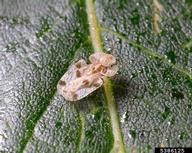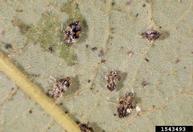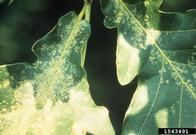Oak lace bug
Corythucha arcuata (Say) (Hemiptera: Tingidae)
Orientation to pest
Oak lace bug, Corythucha arcuata (Say), is a minor pest of various oaks in its native range in North America. The insect may overwinter as either adults or eggs. Adults have lacey wings held flat over the body with an ornate pronotum. Nymphs are mostly black with spines. Feeding begins in early spring at leaf expansion. Eggs are laid on the underside of leaves. Nymphs and adults occur in colonies on foliage where they feed by sucking sap from plant tissues. Damage is similar to the yellow stippling produced by spider mite feeding, but without webbing. Black fecal spots are also present on foliage infested by lace bugs. Dense populations can cause premature leaf drop. There are multiple generations per year.
Hosts commonly attacked
The main hosts of this species are white (Quercus alba L.), bur (Quercus macrocarpa Michx..), and chestnut oaks(Quercus prinus L.).
Distribution
This bug occurs from Alabama and the Carolinas north to southern Canada.
Images of oak lace bug
| Figure 1. Adult of oak lacebug, Corythucha arcuata | Figure 2. Nymphs of oak lace bug on underside of oak leaf | Figure 3. Oak foliage showing damage (yellow stippling) on the upper leaf surface from feeding of oak lace bug |
Important biological control agents related to this pest species
Little is known of the specific natural enemies of the oak lace bug. One generalist predator associated with the species is the mirid Deraeocoris nebulosus (Uhler).
Web links for information on oak lace bug
- Fact Sheet | USDA Forest Service, FHP Southern Region
From "Oak Pests - A Guide to Major Insects, Diseases, Air Pollution, and Chemical Injury"
Articles
- Horn, K. F.; Wright, C. G.; Farrier, M. H. 1979. The lace bugs (Hemiptera: Tingidae) of North Carolina and their hosts. North Carolina Agricultural Experiment Station Technical Bulletin No. 257. 22 pp.
- Wheeler, A. G., Jr., B. R. Stinner, and T. J. Henry. 1975. Biology and nymphal stages of Deraeocoris nebulosus (Hemiptera: Miridae), a predator of arthropod pests on ornamentals. Annals of the Entomological Society of America 68: 1063-1068.






